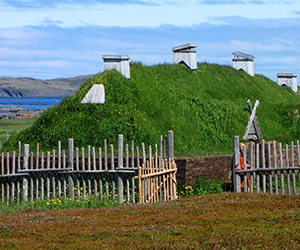CANADA HISTORY - Places-Religious
Andrews Rectory

The St. Andrews Rectory, located in the Red River Settlement of what is now Manitoba, is a significant historical and religious site in Canadian history. Built in 1854 for Reverend William Cockran, the rectory stands as one of the earliest stone structures in the region, marking the shift from traditional log and wooden buildings to more durable and permanent materials. This essay will explore the origins of the rectory, its architectural and historical significance, the context of its creation, and its role in shaping the Red River Settlement during a period of transition.
Origins of the St. Andrews Rectory
The Red River Settlement, established in 1812 by Lord Selkirk under the authority of the Hudson’s Bay Company (HBC), was located at the junction of the Red and Assiniboine Rivers in what is now southern Manitoba. The settlement initially grew slowly, but by the 1830s and 1840s, it became a thriving agricultural community, largely due to its diverse population of Métis, Scottish, and Indigenous inhabitants. As the settlement expanded, there was an increasing need for both spiritual leadership and permanent structures to reflect the growing sense of community.
Reverend William Cockran, an Anglican missionary from the Church Missionary Society (CMS) in England, played a central role in the development of the settlement. Cockran arrived in the Red River Settlement in the early 1820s, where he established several missions and schools. His efforts to bring Christianity to the Indigenous and Métis populations were coupled with initiatives to teach European agricultural methods, hoping to promote both spiritual and material well-being in the settlement.
The construction of the St. Andrews Rectory in 1854 was part of Cockran’s broader vision for a permanent Anglican presence in the settlement. The rectory, located near St. Andrews Church, served as the residence for the clergy, as well as a hub for religious and community activities. Its stone construction marked a departure from the more typical wooden and log structures of the time, reflecting the increasing permanence and stability of the settlement.
Architectural Significance
The St. Andrews Rectory is a prime example of the vernacular Red River architecture that became prominent in the mid-19th century. Constructed from locally quarried limestone, the rectory was designed to withstand the harsh prairie climate, with thick stone walls providing insulation against the cold winters. The building’s design was inspired by Scottish Georgian architecture, which was common among settlers of Scottish descent in the Red River region. It featured symmetrical façades, steeply pitched roofs, and multi-paned windows, all hallmarks of Georgian influence.
The use of stone was not just a practical choice but also a symbol of the settlement’s growing prosperity and stability. Stone structures were more expensive and labor-intensive to build than wooden ones, and their construction signaled a shift towards a more permanent and prosperous community. The rectory’s construction, along with other stone buildings in the area, symbolized the community’s resilience and their desire to establish lasting roots in the Red River Valley.
In addition to the rectory, several similar stone buildings were constructed in the Red River Settlement between the 1840s and 1860s. Many of these buildings were used as residences for retired Hudson’s Bay Company officers and other prominent settlers, who sought to establish themselves in the burgeoning agricultural economy. The rectory thus became part of a larger trend in the settlement towards more permanent, European-style architecture, marking a new phase in the development of the Red River Settlement.
Reverend William Cockran and His Legacy
Reverend William Cockran was instrumental in shaping both the spiritual and social landscape of the Red River Settlement. Born in England in 1798, Cockran was a devout Anglican and a member of the Church Missionary Society. He arrived in the Red River region in 1825 and quickly established himself as a key figure in the settlement. In addition to his missionary work, Cockran was an advocate for agricultural development, teaching European farming techniques to the local Indigenous and Métis populations in an effort to promote self-sufficiency.
Cockran’s influence extended beyond his religious work. He was deeply involved in the community’s education system, founding several schools to educate both children and adults. His belief in the importance of literacy and agricultural training was driven by a desire to uplift the settlement’s inhabitants, particularly the Indigenous and Métis populations, who faced significant challenges in adapting to the economic and social changes brought by European settlers.
By the time the St. Andrews Rectory was built, Cockran had become a well-respected figure in the Red River community. The rectory, as his residence, became a center for religious instruction, community gatherings, and administrative functions. Cockran’s leadership helped solidify the Anglican Church’s role in the settlement and contributed to the region’s overall development.
Cockran’s legacy, however, is complex. While he played a significant role in the growth of the settlement, his efforts to impose European cultural practices on the Indigenous and Métis populations were part of a broader colonial agenda that would have lasting consequences for these communities. The imposition of European religion, education, and agricultural practices often came at the expense of traditional Indigenous ways of life, and Cockran’s work must be viewed in the context of the broader colonial project in Canada.
The Rectory’s Role in Red River Society
The St. Andrews Rectory played a central role in the social and religious life of the Red River Settlement. As one of the first stone buildings in the area, it was a symbol of permanence and stability in a community that was still developing. The rectory served not only as the residence of Reverend Cockran and later Anglican clergy but also as a gathering place for the community. Religious services, meetings, and social events were held there, making it a focal point of the settlement’s spiritual and civic life.
In addition to its religious functions, the rectory was closely tied to the region’s agricultural development. Reverend Cockran’s efforts to teach European farming techniques were centered around the rectory, and the surrounding land was used as a demonstration farm where settlers could learn new methods of crop cultivation and animal husbandry. This agricultural instruction was crucial in helping the Red River Settlement transition from a fur-trading economy to a more diversified agricultural society.
The Legacy of the Rectory and Its Preservation
The St. Andrews Rectory remains an important symbol of the early days of the Red River Settlement and the role of the Anglican Church in the region’s development. Today, the rectory is a designated National Historic Site of Canada, reflecting its significance as a key example of Red River architecture and its role in the settlement’s history.
The rectory has been preserved and restored to reflect its original appearance, offering visitors a glimpse into life in the Red River Settlement during the mid-19th century. The building is now a museum, showcasing artifacts from the period and providing educational programs on the history of the settlement and its inhabitants. The museum offers insights into the architectural, social, and religious history of the region, highlighting the contributions of figures like Reverend Cockran and the broader community of settlers and Indigenous peoples.
The St. Andrews Rectory stands as a testament to the early history of the Red River Settlement and the efforts of figures like Reverend William Cockran to establish a permanent and thriving community in the heart of what would become Manitoba. Its construction marked a turning point in the settlement’s development, symbolizing the shift towards permanence and prosperity. As one of the first stone structures in the region, the rectory remains an enduring symbol of the settlement’s resilience and the complex legacy of European colonization in Canada. Today, it serves as a museum and historic site, preserving the rich history of the Red River Settlement for future generations to explore and understand.
Chat
Cite Article : Reference: www.canadahistory.com/sections/documents/documents.html
Source: NA



